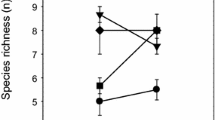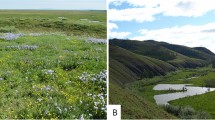Abstract
African savannahs are among the few places on earth where diverse communities of mega- and meso-sized ungulate grazers dominate ecosystem functioning. Less conspicuous, but even more diverse, are the communities of herbivorous insects such as grasshoppers, which share the same food. Various studies investigated the community assembly of these groups separately, but it is poorly known how ungulate communities shape grasshopper communities. Here, we investigated how ungulate species of different body size alter grasshopper communities in a South African savannah. White rhino is the most abundant vertebrate herbivore in our study site. Other common mesoherbivores include buffalo, zebra and impala. We hypothesized that white rhinos would have greater impact than mesoherbivores on grasshopper communities. Using 10-year-old exclosures, at eight sites we compared the effects of ungulates on grasshopper communities in three nested treatments: (i) unfenced plots (‘control plots’) with all vertebrate herbivores present, (ii) plots with a low cable fence, excluding white rhino (‘megaherbivore exclosures’), and (iii) plots with tall fences, excluding all herbivores larger than rodents (‘complete ungulate exclosures’). In each plot, we collected data of vegetation structure, grass and grasshopper community composition. Complete ungulate exclosures contained 30 % taller vegetation than megaherbivore exclosures and they were dominated by different grass and grasshopper species. Grasshoppers in complete ungulate exclosures were on average 3.5 mm longer than grasshoppers in megaherbivore exclosures, possibly due to changes in plant communities or vegetation structure. We conclude that surprisingly, in this megaherbivore hotspot, mesoherbivores, instead of megaherbivores, most strongly affect grasshopper communities.



Similar content being viewed by others
References
Abràmoff MD, Hospitals I, Magalhães PJ, Abràmoff M (2004) Image processing with Image. J Biophoton Int 11:36–52. doi:10.1117/1.3589100
Arsenault R, Owen-Smith N (2002) Facilitation versus competition in grazing herbivore assemblages. Oikos 97:313–318. doi:10.1034/j.1600-0706.2002.970301.x
Arsenault R, Owen-Smith N (2011) Competition and coexistence among short-grass grazers in the Hluhluwe-iMfolozi Park, South Africa. Can J Zool 89:900–907. doi:10.1139/z11-067
Bates D, Maechler M, Bolker B (2011) Lme4: Linear mixed-effects models using S4 classes. R package version 0.999375-39
Behmer ST (2009) Insect herbivore nutrient regulation. Annu Rev Entomol 54:165–187. doi:10.1146/annurev.ento.54.110807.090537
Behmer ST, Joern A (2008) Coexisting generalist herbivores occupy unique nutritional feeding niches. Proc Natl Acad Sci USA 105:1977–1982. doi:10.1073/pnas.0711870105
Belovsky GE (1997) Optimal foraging and community structure: the allometry of herbivore food selection and competition. Evol Ecol 11:641–672. doi:10.1023/A:1018430201230
Belovsky GE, Slade JB, Stockhoff BA (1990) Susceptibility to predation for different grasshoppers—an experimental study. Ecology 71:624–634. doi:10.2307/1940316
Cromsigt JPGM, Olff H (2008) Dynamics of grazing lawn formation: an experimental test of the role of scale-dependent processes. Oikos 117:1444–1452. doi:10.1111/j.2008.0030-1299.16651.x
Cromsigt JPGM, Te Beest M (2014) Restoration of a megaherbivore—landscape-level impacts of white rhinoceros in Kruger National Park, South Africa. J Ecol. doi:10.1111/1365-2745.12218
Cromsigt JPGM, Prins HHT, Olff H (2009) Habitat heterogeneity as a driver of ungulate diversity and distribution patterns: interaction of body mass and digestive strategy. Divers Distrib 15:513–522. doi:10.1111/j.1472-4642.2008.00554.x
Dirsh VM (1965) The African genera of Acridoidea. Cambridge University Press, Cambridge
Dufrene M, Legendre R (1997) Species assemblages and indicator species: the need for a flexible asymmetrical approach. Ecol Monogr 67:345–366. doi:10.2307/2963459
Evans EW, Bailey KW (1993) Sampling grasshoppers (Orthoptera, Acrididae) in Utah grasslands—Pan trapping versus sweep sampling. J Kans Entomol Soc 66:214–222
Gebeyehu S, Samways MJ (2003) Responses of grasshopper assemblages to long-term grazing management in a semi-arid African savanna. Agric Ecosyst Environ 95:613–622. doi:10.1016/S0167-8809(02)00178-0
Goslee SC, Urban DL (2007) The ecodist package for dissimilarity-based analysis of ecological data. J Stat Softw 22:1–19
Hagenah N, Prins HHT, Olff H (2009) Effects of large herbivores on murid rodents in a South African Savanna. J Trop Ecol 25:483–492. doi:10.1017/S0266467409990046
Harrison RG (1980) Dispersal polymorphisms in insects. Annu Rev Ecol Syst 11:95–118. doi:10.1146/annurev.es.11.110180.000523
Hothorn T, Bretz F, Westfall P (2008) Simultaneous inference in general parametric models. Biom J 50:346–363. doi:10.1002/bimj.200810425
Joern A (1982) Vegetation structure and microhabitat selection in grasshoppers (Orthoptera, Acrididae). Southwest Natl 27:197–209. doi:10.2307/3671144
Joern A (2005) Disturbance by fire frequency and bison grazing modulate grasshopper assemblages in tallgrass prairie. Ecology 86:861–873. doi:10.1890/04-0135
Joern A, Provin T, Behmer ST (2012) Not just the usual suspects: insect herbivore populations and communities are associated with multiple plant nutrients. Ecology 93:1002–1015. doi:10.1890/11-1142.1
Johnsen P (1982) Acridoidea of Zambia. Zoological laboratory, Aarhus University, Denmark
Johnsen P (1991) Acridoidea of Botswana. Zoological laboratory, Aarhus University, Denmark
Jonas JL, Joern A (2007) Grasshopper (Orthoptera: Acrididae) communities respond to fire, bison grazing and weather in North American tallgrass prairie: a long-term study. Oecologia 153:699–711. doi:10.1007/s00442-007-0761-8
Kingsolver JG, Ragland GJ, Diamond SE (2008) Evolution in a constant environment: thermal fluctuations and thermal sensitivity of laboratory and field populations of Manduca sexta. Evolution 63:537–541. doi:10.1111/j.1558-5646.2008.00568.x
Kleynhans EJ, Jolles AE, Bos MRE, Olff H (2011) Resource partitioning along multiple niche dimensions in differently sized African savanna grazers. Oikos 120:591–600. doi:10.1111/j.1600-0706.2010.18712.x
Kruess A, Tscharnkte T (2002) Grazing intensity and the diversity of grasshoppers, butterflies and trap-nesting bees and wasps. Conserv Biol 16:1570–1580. doi:10.1046/j.1523-1739.2002.01334.x
McNaughton SJ (1985) Ecology of a grazing ecosystem—The Serengeti. Ecol Monogr 55:259–294. doi:10.2307/1942578
Oksanen J, Guillaume Blanchet F, Kindt R, Legendre P, Minchin PR, O’Hara RB, Simpson GL, Solymos P, Stevens MHH, Wagner H (2010) Vegan: Community Ecology Package—R package version 1.17-3
Olff H, Ritchie ME (1998) Effects of herbivores on grassland diversity. Trends Ecol Evol 13:261–265. doi:10.1016/S0169-5347(98)01364-0
Olff H, Ritchie ME, Prins HHT (2002) Global environmental controls of diversity in large herbivores. Nature 415:901–904. doi:10.1038/415901a
Owen-Smith NR (1988) Megaherbivores. Cambridge University Press, Cambridge
Pinheiro J, Bates D, DebRoy S (2011) nlme: Linear and nonlinear mixed effects models. R package version 3.1-101
Prins HHT, Olff H (1998) Species richness of African grazer assemblages: towards a functional explanation. In: Newbery DM, Prins HHT, Brown ND (eds) Dynamics of tropical communities. Cambridge University Press, Cambridge
Reich PB, Walters MB, Ellsworth DS (1997) From tropics to tundra: global convergence in plant functioning. Proc Natl Acas Sci USA 94:13730–13734. doi:10.1073/pnas.94.25.13730
Ritchie ME (2000) Nitrogen limitation and trophic vs. abiotic influences on insect herbivores in a temperate grassland. Ecology 81:1601–1612. doi:10.1890/0012-9658(2000)
Roberts DW (2010) Labdsv: Ordination and multivariate analysis for ecology—R package version 1.4-1
Samways MJ (1999) Diversity and conservation status of South African dragonflies (Odonata). Odontologica 28:13–62
Simpson SJ, Raubenheimer D (1993) A multilevel analysis of feeding behaviour: the geometry of nutritional decisions. Philos Trans R Soc Lond Ser B 342:381–402. doi:10.1098/rstb.1993.0166
Sinclair ARE (1975) The resource limitation of trophic levels in tropical grassland ecosystems. J Anim Ecol 44:497–520. doi:10.2307/3608
Staver AC, Bond WJ, Stock WD, van Rensburg SJ, Waldram MS (2009) Browsing and fire interact to suppress tree density in an African savanna. Ecol Appl 19:1909–1919. doi:10.1890/08-1907.1
Stock WD, Bond WJ, van de Vijver CADM (2010) Herbivore and nutrient control of lawn and bunch grass distributions in a Southern African savanna. Plant Ecol 206:15–27. doi:10.1007/s11258-009-9621-4
Van der Plas F, Anderson TM, Olff H (2012) Trait similarity patterns within grass and grasshopper communities: multitrophic community assembly at work. Ecology 93:836–846. doi:10.1890/11-0975.1
Van der Plas F, Zeinstra P, Veldhuis M, Fokkema R, Tielens E, Howison R, Olff H (2013) Responses of savannah lawn and bunch grasses to water limitation. Plant Ecol 214:1157–1168. doi:10.1007/s11258-013-0240-8
Waldram MS, Bond WJ, Stock WD (2008) Ecological engineering by a mega-grazer: white rhino impacts on a South African savannah. Ecosystems 11:101–112. doi:10.1007/s10021-007-9109-9
Weiher E, van der Werf A, Thompson K, Roderick M, Garnier E, Eriksson O (1999) Challenging Theophrastus: a common core list of plant traits for functional ecology. J Veg Sci 10:609–620. doi:10.2307/3237076
Westoby M, Falster DS, Moles AT, Vesk PA, Wright IJ (2002) Plant ecological strategies: some leading dimensions of variation between species. Ann Rev Ecol Syst 33:125–159. doi:10.1146/annurev.ecolsys.33.010802.150452
Whateley A, Porter RN (1983) The woody vegetation communities of the Hluhluwe-Corridor-Umfolozi game reserve complex. Bothalia 14:745–758
Acknowledgments
We thank William Bond and the ZLTP for setting up the exclosures investigated in this study. Additionally, we thank the SABRE and ZLTP team for maintaining exclosures over the years. We are also grateful to Maarten Schrama, Nelly van Eck, Julia Wakeling and the SABRE team for the coordination of, and helping with, the data collection. Thanks must also go to Roel van Klink, Cleo Graf and Maarten Schrama, who provided useful comments on earlier drafts of this manuscript. Finally, we want to thank KZN wildlife for permitting us to perform this study.
Author information
Authors and Affiliations
Corresponding author
Additional information
Communicated by Riccardo Bommarco.
Electronic supplementary material
Below is the link to the electronic supplementary material.
Rights and permissions
About this article
Cite this article
van der Plas, F., Olff, H. Mesoherbivores affect grasshopper communities in a megaherbivore-dominated South African savannah. Oecologia 175, 639–649 (2014). https://doi.org/10.1007/s00442-014-2920-z
Received:
Accepted:
Published:
Issue Date:
DOI: https://doi.org/10.1007/s00442-014-2920-z




